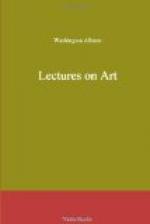Of the immutable nature of this peculiar Truth, we have a like instance in the Farnese Hercules; the work of the Grecian sculptor Glycon,—we had almost said his immortal offspring. Since the time of its birth, cities and empires, even whole nations, have disappeared, giving place to others, more or less barbarous or civilized; yet these are as nothing to the countless revolutions which have marked the interval in the manners, habits, and opinions of men. Is it reasonable, then, to suppose that any thing not immutable in its nature could possibly have withstood such continual fluctuation? But how have all these changes affected this visible image of Truth? In no wise; not a jot; and because what is true is independent of opinion: it is the same to us now as it was to the men of the dust of antiquity. The unlearned spectator of the present day may not, indeed, see in it the Demigod of Greece; but he can never mistake it for a mere exaggeration of the human form; though of mortal mould, he cannot doubt its possession of more than mortal powers; he feels its essential life, for he feels before it as in the stirring presence of a superior being.
Perhaps the attempt to give form and substance to a pure Idea was never so perfectly accomplished as in this wonderful figure. Who has ever seen the ocean in repose, in its awful sleep, that smooths it like glass, yet cannot level its unfathomed swell? So seems to us the repose of this tremendous personification of strength: the laboring eye heaves on its slumbering sea of muscles, and trembles like a skiff as it passes over them: but the silent intimations of the spirit beneath at length become audible; the startled imagination hears it in its rage, sees it in motion, and sees its resistless might in the passive wrecks that follow the uproar. And this from a piece of marble, cold, immovable, lifeless! Surely there is that in man, which the senses cannot reach, nor the plumb of the understanding sound.




